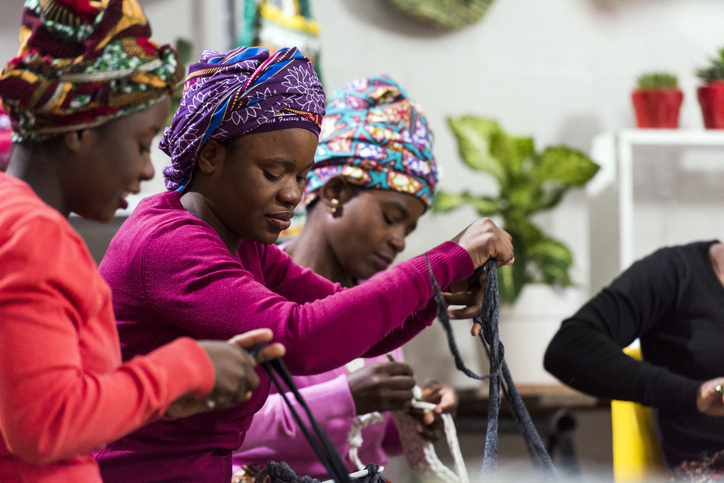Microfinance can be a way to broaden access to formal financial opportunities, and in some settings, it seems to have the potential to reduce poverty and promote stronger economic empowerment of women. This column reports evidence from a microfinance company in Ghana showing relatively higher women’s empowerment and lower poverty among clients with loans, relative to non-clients without a loan.
A high level of poverty and a low level of women’s economic empowerment are two of the common economic and social features of developing countries. Efforts towards achieving Sustainable Development Goals 1 (no poverty) and 5 (gender equality) have advocated for several measures to reduce poverty and empower women. These include improving access to microcredit – loans provided to low-income households and small and micro business enterprises.
Empirical studies are yet to document conclusively that microcredit reduces poverty and increases women’s empowerment. Indeed, some research questions its effectiveness. One study finds no difference in outcomes for health, education, and women’s economic empowerment, while another finds no significant changes in poverty. Similarly, research on Uganda and China finds little to no evidence of the poverty-reducing effects of microfinance.
However, studies such as this one and a second article here provide evidence that microcredit does increase women’s empowerment. An example of the poverty-reducing effect of microcredit is provided here. A recent systematic review of microfinance in sub-Saharan Africa suggests that evidence for the impact of microcredit on poverty and economic empowerment outcomes depends on the choice of methodology and context of the study.
The positive evidence is not as clear-cut as might be expected. For example, one study finds that microfinance led women to switch from agriculture to non-agricultural activities, and provided short-term gains. But for longer-term gains (two years or more), income, savings, consumption, and other wellbeing indicators did not significantly increase. Another study finds that the effects are strong and remain until six years, but decline thereafter.
One recent study does not find significant effects of microfinance on business profits, revenue, and household assets from research on eight randomized control trials. But combining all eight studies does show significant effects of microfinance.
In our study we explore the effects of microcredit on women’s economic empowerment and poverty. The study was based on a survey of randomly sampled female clients of a microfinance company and women who have never borrowed from a formal institution before, systematically sampled from the Savannah and Northern regions of Ghana. Our study adds to the body of work on the impact of microcredit on both poverty and women’s economic empowerment by providing evidence and adapting more recent methods from econometric evaluation.
The sample consisted of 411 women who were clients of a microfinance company (forming the ‘treatment’ group) and 541 women who had never borrowed from a formal financial institution (forming the main ‘control’ group). To ensure similarity of our comparison groups and rule out differences between the treatment and control groups due to unobserved differences, we compared women with one loan cycle to those with no loans, and with two to three loans, and the latter were compared with women with four or more loan cycles.
Microcredit and women’s economic empowerment
We obtained indices for power, agency, and economic advancement to provide a measure of women’s economic empowerment. We found relatively higher women’s empowerment among the company’s clients. In some cases, women with a higher number of loans had relatively higher empowerment indices compared with those with a lower number of loans. The clients with loans had relatively better empowerment outcomes compared with the control respondents
Figure 1 summarizes the results. The prominent result is the difference between clients who have borrowed once and women who have not borrowed before. We find that for several indices – share of household spending; social capital; personal autonomy; agency or decision-making at home; use of phone and technology in business; and decision-making in business and business practice – the women with one loan cycle did better than women with no loans.
Figure 1: Results of women’s economic empowerment

Microcredit and poverty
We also found a relatively lower level of poverty among the company’s clients after controlling for household, district, and individual characteristics compared with the control group.
Both the Poverty Probability Index (PPI) poverty rates and consumption per capita expenditures indicate that those who received a loan had a lower level of poverty compared with those who did not. We reached the same conclusion regarding clients with more loans compared with those with fewer loans.
As shown in Figure 2, women with one loan cycle experienced a reduction in both ‘extreme poverty’ and ‘poverty’ compared with women with no loans. The result is similar in the comparison of women with four or more loan cycles and women with two to three loan cycles.
Figure 2: Comparing poverty between the various groups

Key insights from focus group discussions
Five narratives from our focus group conversations with the women are that:
- The microfinance company’s clients feel economically empowered.
- Access to loans reduces violence at home for the clients.
- Responsibilities at home negatively affect running a business (a view shared by both the treatment and control groups).
- Larger households spend profits and loans on consumption.
- Borrowing from family and friends only meets basic needs (a view shared by both the treatment and control groups).
Our conversations suggest that the microfinance services benefit women via several different channels and in several different ways. For some households the increased capacity to consume was the greatest impact. For example, an older woman explained that the loan allowed her to meet family emergencies, while others indicated that it helped them to purchase business assets.
In addition, economic empowerment from loans resulted in fewer financial disagreements at home with male spouses. Loans reduced the financial burden on men, creating more peace and reducing violence at home. One woman suggested that some of the violence was due to requesting money from the men, so being able to cater for the kids and oneself without asking the spouse for money led to fewer disagreements and violence.
Most participants agreed that home responsibilities constrained their ability to run their businesses effectively. Having to prepare meals for the family and carrying out other household chores limited the time they had to attend to customers.
In some cases, the size of households directly affected the ability of clients to reinvest the profits back into their businesses. The larger households required more resources to meet household needs.
Nonetheless, the loans were important in improving their livelihoods and the profitability of their businesses. In large households, the loans and any increase in profits leaked into household consumption rather than increasing the women’s investments or being used to expand their businesses.
Conclusion
Our evidence suggests that microfinance loans can empower women to take control of their household and business spending choices. To some extent, the loans can contribute to improving poverty outcomes and allow women to consume relatively more items at home.
Based on empirical evidence, poor households tend to be larger than non-poor households on average. One key implication of this is that due to several large households relying on microfinance, they end up spending borrowed money on family emergencies and consumption rather than family business expansions.






